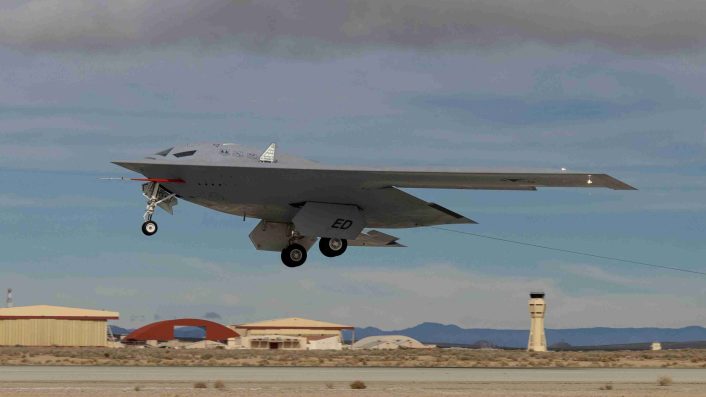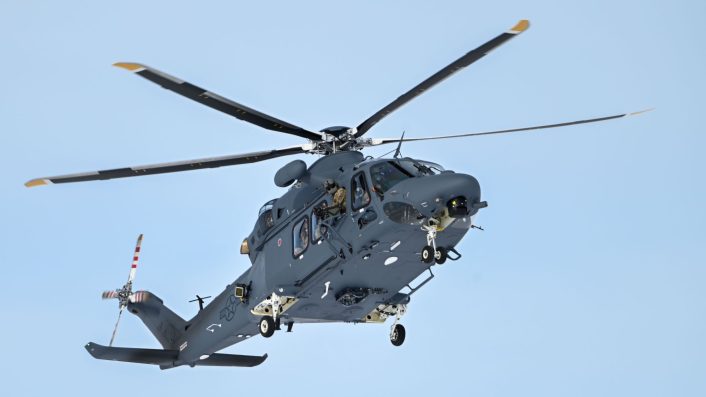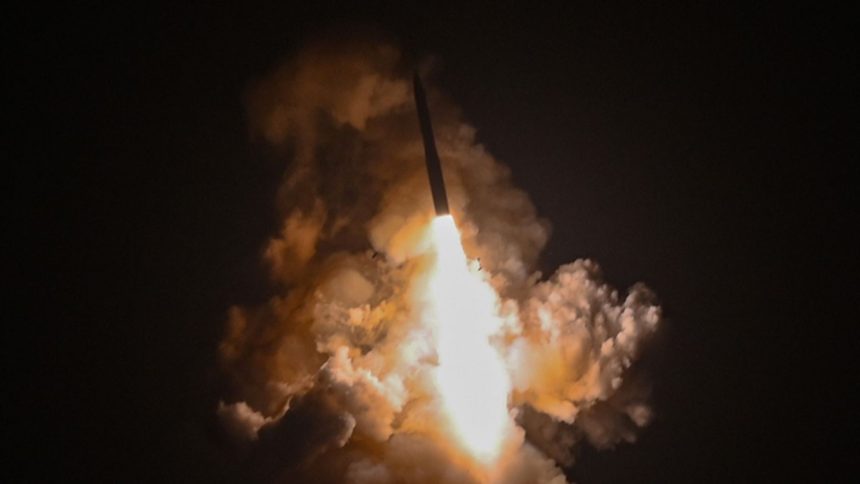U.S. Air Force and Navy leaders reiterated the importance of the nuclear triad and the need to maintain an effective deterrent before adversaries.
U.S. military leaders testified the importance of modernizing the country’s nuclear triad, which includes land, air and sea delivery platforms, before a Senate Armed Services Committee hearing on May 20, 2025. This was followed by the Air Force Global Strike Command (AFGSC) conducting a “routine and periodic” test launch of a Minuteman III Inter-Continental Ballistic Missile (ICBM), equipped with a Mark-21 High Fidelity Re-Entry Vehicle, a day later, on May 21, from Vandenberg Space Force Base (SFB) in California.
That reentry vehicle traveled approximately 4,200 miles to the U.S. Army Space and Missile Defense Command’s Ronald Reagan Ballistic Missile Defense Test Site at Kwajalein Atoll in the Marshall Islands. During the flight, it was tracked by Reagan Test Site’s sensors “including high-fidelity metric and signature radars, as well as optical sensors and telemetry.”
“This test launch is part of routine and periodic activities designed to demonstrate that the United States’ nuclear deterrent remains safe, secure, reliable and effective in deterring 21st-century threats and reassuring our allies,” said the Air Force Global Strike Command. “With more than 300 similar tests conducted in the past, this test is part of the Nation’s ongoing commitment to maintaining a credible deterrent and is not a response to current world events.”
AFGSC Airmen & Guardians supported an operational test launch of an unarmed Minuteman III ICBM on May 21 at 12:01 am PT. This test validates the safety & readiness of the weapon system.
Read here: https://t.co/xIWxupsreP@US_STRATCOM | @usairforce | @SpaceForceDoD | @ArmySMDC pic.twitter.com/CGV7ciUUiu
— Air Force Global Strike Command (@AFGlobalStrike) May 21, 2025
Need for continuous support
Before the lawmakers, Air Force Gen. Thomas A. Bussiere, commander of Air Force Global Strike Command and Air Forces Strategic-Air, U.S. Strategic Command, identified two legs of the nuclear triad – the intercontinental ballistic missiles and the B-21 Raider and B-52J Stratofortress strategic bombers – as well as the nuclear command, control and communications architecture, as the ones involved in the modernization.
The ICBM mention, although not explicitly stated, refers to the LGM-35 Sentinel ICBM currently being developed to replace the legacy Minuteman III . This was also mentioned in the test launch’s press release, saying that the “LGM-35A Sentinel will replace the Minuteman III ICBM, and until full capability is achieved, the Air Force is committed to ensuring Minuteman III remains a viable deterrent.”
Bussiere said other modernization efforts include the MH-139 Gray Wolf helicopter. The helicopter is currently replacing the aging UH-1N Huey in the nuclear security mission.
The General also mentioned Russia and China are posing the U.S. “a serious nuclear threat” with “modern and diverse arsenals,” while North Korea poses an “escalating threat” and there is also the “potential of a nuclear-armed Iran” to be considered. “This underscores the importance of fielding a flexible and modern nuclear force to effectively deter them,” Bussiere added, seeking support to this cause as the “Air Force nuclear enterprise is in a critical phase of transition.”
MM-III launch
📸: USSF by Airman 1st Class Olga Houtsma pic.twitter.com/3ysgkcUxjO
— Doha (@Doha104p3) June 4, 2024
The director of the U.S. Navy’s Strategic Systems Program Vice Adm. Johnny Wolfe Jr. called the Navy’s submarine-based leg, made of the Trident II Submarine-Launched Ballistic Missiles (SLBM), “the bedrock of our national security,” defining it the “most survivable” leg, being “safe, secure, effective and credible.” He also identified the Conventional Prompt Strike hypersonic program as one of the programs for which the Navy is responsible.
Minuteman III launch and Sentinel ICBMs
The appeal to modernize the nuclear triad also comes after projections released by the Congressional Budget Office (CBO) in April, which estimated that the U.S. nuclear weapons arsenal would cost nearly $1 trillion over the next decade. Specifically, the projections put the figure at $946 billion between 2025 and 2034.
A majority of the rising costs are attributed to the LGM-35 Sentinel ICBM, meant to replace the Minuteman IIIs from the 2030s, which triggered a Nunn-McCurdy Review after an 81% cost increase touching close to $140 billion. A major driver of the spike in the Sentinel’s cost was the unforeseen new massive land-based infrastructure, including new silos, command and control facilities, maintenance equipment, communications, electronics and cabling systems.
Earlier this month, the U.S. Air Force was reported to be considering constructing these new silos for the Sentinel, entailing excavations at or beyond 80 feet deep at around 400 sites across continental U.S. Existing Minuteman III silos are based in Wyoming, North Dakota, Montana, Colorado, and Nebraska. New silos would be required at Vandenberg SFB for test launches.
Report to Congress on LGM-35A Sentinel ICBM – USNI Newshttps://t.co/lLR0IsQjWO pic.twitter.com/ELfOmEjepc
— U.S. Naval Institute (@NavalInstitute) November 11, 2024
B-21 Raider, B-52J bombers and B61-13 nuclear bomb
The B-21 Raider, touted as the world’s first sixth generation aircraft, is seen as a quantum leap in long-range standoff delivery of strategic conventional and nuclear weapons through airborne stealth. Northrop Grumman was awarded the second low-rate initial production contract in late-2024, with recent reports suggesting the program is within budgetary and delivery timelines.
While there are 100 B-21s on order, the USAF has expressed it desires a fleet of 145 airframes for a “high-end penetrating capability.” Air Force and Northrop Grumman officials said in April that the bomber is expected to arrive at Ellsworth AFB in South Dakota by the mid-2020s.
The upgraded B-52J also took a step forward in Dec. 2024, when Rolls-Royce successfully completed the F130 engines Critical Design Review (CDR). Other features in the B-52J include a modified variant of the F/A-18EF Super Hornet’s APG-79 AESA radar; a cleaner front-nose; digital multifunction displays inside the cockpit; newer Electronic Warfare (EW) capability; and a host of other electronics and avionics.
Meanwhile, the B61-13 nuclear gravity bomb saw its first completed unit being unveiled on May 19, 2025 in Texas. Beside a higher yield than the B61-12, it has improved guidance, accuracy, and safety and security features. However, the B61-13 is meant to be used by the B-21 Raider only.

MH-139A Grey Wolf
In support of the U.S.’ nuclear security mission, which includes patrolling its nuclear bases and underground launch silos hosting the Minuteman III ICBM, the MH-139A Grey Wolf was put through an Initial Operational Test and Evaluation (IOT&E) for a week from Jan. 28, 2025. This was followed by another IOT&E exercise on Feb. 21, 2025, which will lead the helicopter to eventually replace the UH-1N Huey.
The MH-139A Grey Wolf is a variant of the AW139M, itself the militarized version of Leonardo’s AW139 commercial helicopter. The primary role of the helicopter will be to support the nuclear security mission, conducting aerial patrols near nuclear missile bases and responding to contingency situations. Leonardo first produces the base helicopter at its facility in northeast Philadelphia, and Boeing then modifies and outfits the aircraft with the necessary military equipment.
The 550th Helicopter Squadron at Malmstrom AFB received the first production Grey Wolf on Aug. 5, 2024, as a part of a $285 million Low-Rate Initial Production (LRIP) order of 13 helicopters approved in 2023.










